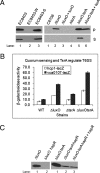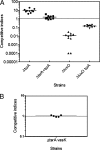Quorum sensing and a global regulator TsrA control expression of type VI secretion and virulence in Vibrio cholerae
- PMID: 21084635
- PMCID: PMC3000250
- DOI: 10.1073/pnas.1014998107
Quorum sensing and a global regulator TsrA control expression of type VI secretion and virulence in Vibrio cholerae
Abstract
Vibrio cholerae is a human pathogen that causes the life-threatening diarrheal disease cholera. A type VI secretion system (T6SS) was recently shown to be required for full virulence in the O37 serogroup strain V52, which causes only sporadic human disease, but T6SS is not expressed in seventh pandemic O1 El Tor strains under standard laboratory conditions. In this study, we show that in the O1 El Tor strain C6706, T6SS is repressed by both quorum sensing and the uncharacterized protein VC0070 (TsrA). Disruption of TsrA and the quorum sensing regulator LuxO induces expression and secretion of the T6SS substrate Hcp, and this is dependent on the downstream regulator HapR, which directly binds to the promoter region of the T6SS genes hcp1 and hcp2 to induce expression. The activated T6SS in C6706 is functional and can translocate the effector protein VgrG-1 into macrophage cells, and T6SS activation leads to fecal diarrhea and intestinal inflammation in infant rabbits. Using an infant mouse infection model, we show that deletion of tsrA results in a 9.3-fold increase in intestinal colonization compared with wild type. TsrA functions as a global regulator to activate expression of hemagglutinin protease and repress cholera toxin and toxin coregulated pilus. Our findings provide significant insight into the molecular mechanism of T6SS and ToxT regulon gene regulation by quorum sensing and TsrA.
Conflict of interest statement
The authors declare no conflict of interest.
Figures






Similar articles
-
Transcriptional Silencing by TsrA in the Evolution of Pathogenic Vibrio cholerae Biotypes.mBio. 2020 Nov 24;11(6):e02901-20. doi: 10.1128/mBio.02901-20. mBio. 2020. PMID: 33234688 Free PMC article.
-
Constitutive type VI secretion system expression gives Vibrio cholerae intra- and interspecific competitive advantages.PLoS One. 2012;7(10):e48320. doi: 10.1371/journal.pone.0048320. Epub 2012 Oct 26. PLoS One. 2012. PMID: 23110230 Free PMC article.
-
Quorum sensing regulation of the two hcp alleles in Vibrio cholerae O1 strains.PLoS One. 2009 Aug 24;4(8):e6734. doi: 10.1371/journal.pone.0006734. PLoS One. 2009. PMID: 19701456 Free PMC article.
-
Rules of Engagement: The Type VI Secretion System in Vibrio cholerae.Trends Microbiol. 2017 Apr;25(4):267-279. doi: 10.1016/j.tim.2016.12.003. Epub 2016 Dec 24. Trends Microbiol. 2017. PMID: 28027803 Free PMC article. Review.
-
Expression of Vibrio cholerae virulence genes in response to environmental signals.Curr Issues Intest Microbiol. 2002 Sep;3(2):29-38. Curr Issues Intest Microbiol. 2002. PMID: 12400636 Review.
Cited by
-
Mechanisms of Bacterial Tolerance and Persistence in the Gastrointestinal and Respiratory Environments.Clin Microbiol Rev. 2018 Aug 1;31(4):e00023-18. doi: 10.1128/CMR.00023-18. Print 2018 Oct. Clin Microbiol Rev. 2018. PMID: 30068737 Free PMC article. Review.
-
Design of novel anti-quorum sensing peptides targeting LuxO to combat Vibrio cholerae pathogenesis.In Silico Pharmacol. 2023 Oct 27;11(1):30. doi: 10.1007/s40203-023-00172-2. eCollection 2023. In Silico Pharmacol. 2023. PMID: 37899970 Free PMC article.
-
Sensing of intracellular Hcp levels controls T6SS expression in Vibrio cholerae.Proc Natl Acad Sci U S A. 2021 Jun 22;118(25):e2104813118. doi: 10.1073/pnas.2104813118. Proc Natl Acad Sci U S A. 2021. PMID: 34161288 Free PMC article.
-
Proteus mirabilis Employs a Contact-Dependent Killing System against Competing Enterobacteriaceae.mSphere. 2021 Aug 25;6(4):e0032121. doi: 10.1128/mSphere.00321-21. Epub 2021 Jul 28. mSphere. 2021. PMID: 34319125 Free PMC article.
-
Characterization of the RpoN regulon reveals differential regulation of T6SS and new flagellar operons in Vibrio cholerae O37 strain V52.Nucleic Acids Res. 2012 Sep;40(16):7766-75. doi: 10.1093/nar/gks567. Epub 2012 Jun 20. Nucleic Acids Res. 2012. PMID: 22723378 Free PMC article.
References
Publication types
MeSH terms
Substances
Grants and funding
LinkOut - more resources
Full Text Sources
Other Literature Sources
Molecular Biology Databases
Miscellaneous

